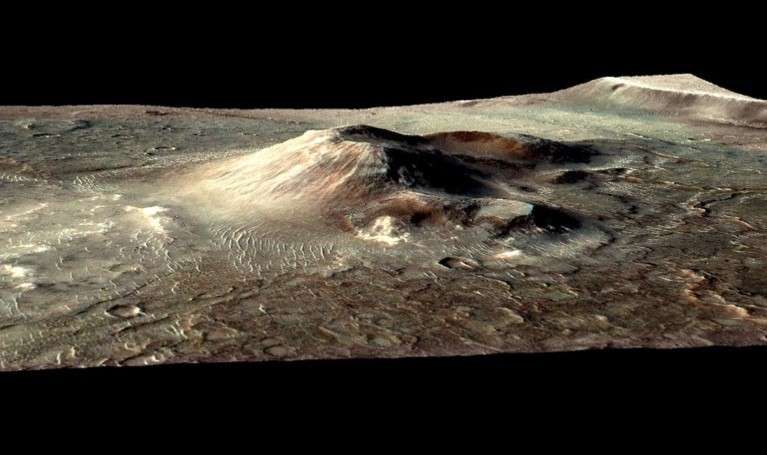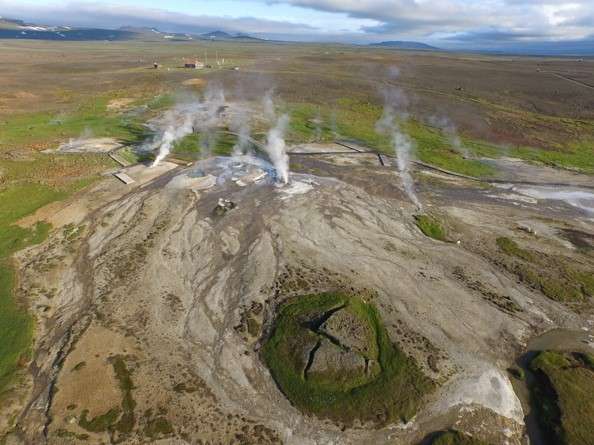Seeking signs of life in an ancient Martian hot spring

A fundamental motivation for our exploration of Mars is the search for the presence of extinct or extant life. But where should we look?
New knowledge of Mars will allow scientists to tailor their search methods to specific locations. The past decade of rover and orbiter exploration has revealed numerous locations that would be ideal for hosting and preserving evidence of life. However, these places have often proven to be difficult to land on and explore.
As a research scientist at the SETI Institute, I am developing a mission to explore a target that would be ideal to develop, host and preserve signs of life. Tucked away in the Nili Patera caldera on Mars' Syrtis Major volcano is one of the best potential examples of a hot spring deposit on the planet. I pieced together the compositional and morphologic evidence to identify this feature back in 2010, while still in graduate school, and I've been working to understand it ever since.
Hot springs are a key focus for exploration since they are known to host and protect a variety of biologic communities on Earth. In addition, they naturally create silica sinter surface deposits that naturally preserve evidence for life. Hot springs also result in relatively focused, or confined, surface features, making their physical exploration much easier than other more diffuse terrains.
However, the nature and specific science of these sites make them too focused for the large roving laboratories that are now engaged in the surface exploration of the Red Planet. While the Curiosity Rover and future Mars2020 Rover are both incredibly capable vehicles, neither is well-suited for the specific challenges of exploring for life in a hot spring deposit. This creates a need for a mission designed to address the search strategies for these features.
This summer, I'll be leading a team from across the country and beyond to test out the instruments and mission planning needed for a Martian hot spring mission. This project is funded by the NASA Planetary Science and Technology Through Analog Research (PSTAR) program, designed for the scientific and technological advancement of space exploration concepts. The team will be deployed to Iceland to document and analyze several sinter deposits carefully selected to resemble what is found on Mars. A campaign of geologic, spectral and geophysical mapping, along with abundant laboratory analysis, will determine the right instruments and platform to bring to Mars.
My team includes some of the leading hot spring scientists in the world, and is full of early-career scientists eager to push space exploration into a new, more focused era. We'll be joined by Jack Farmer from Arizona State University, one of the world's leading hot spring paleontologists with decades of experience in Mars research. He and his student, Marisol Juarez Rivera, will be creating maps of all of the sinter features to provide a geographic understanding of where in the system it is best to search for life.

Mario Parente of the University of Massachusetts, Amherst, and his student Yuki Itoh, will be using hyperspectral imaging techniques to map out the distribution of minerals and mineral phases. This will teach us how to home in on the right materials for investigation.
Dominique Tobler from the University of Copenhagen will be conducting a hydrothermal water analysis campaign to tie the nature of the spring to the deposits. On Mars, the hot spring waters are long gone, and this connection is critical to understanding the ancient environment that may have hosted life.
Carolina Munoz-Saez, a recent graduate of the University of California in Berkeley, is an expert on the hydrothermal and geyser systems in a similar site located near the town of El Tatio, in Chile. She will be looking at the 3-D reconstruction of sinters to understand how the rocks were made and modified by life.
Kathleen Craft of Johns Hopkins' Applied Physics Lab will be documenting the organic molecule distribution within the sinters to understand how key evidence of life is preserved and displayed for future exploration. Craft's participation on this project is supported by the Lewis and Clark Fund for Astrobiology Field Scholars from NASA's Astrobiology Institute.
Finally, graduate student David Susko from Louisiana State University will be deploying a ground penetrating radar (GPR) to develop a 3-D view of the sinters and their development with time. While the surface deposits are the easiest to access, it is the buried ones that are the best protected from the harsh Martian surface.
This field team is supported by a large scientific support network that will independently test out the data to examine multiple mission scenarios in deciding how best to explore Mars. This effort is part of a new initiative to develop exploration for the subtleties of specific planetary environments.
Building large, broadly capable exploration robots, as has been done so far, is critical to the early exploration of planets. But as we learn more about the diversity of targets, we need to focus on specific questions. This is the objective and plan for our current effort in Iceland as we develop the science and technology that will allow us to seek signs of life in ancient Martian hot springs.
Provided by SETI Institute




















